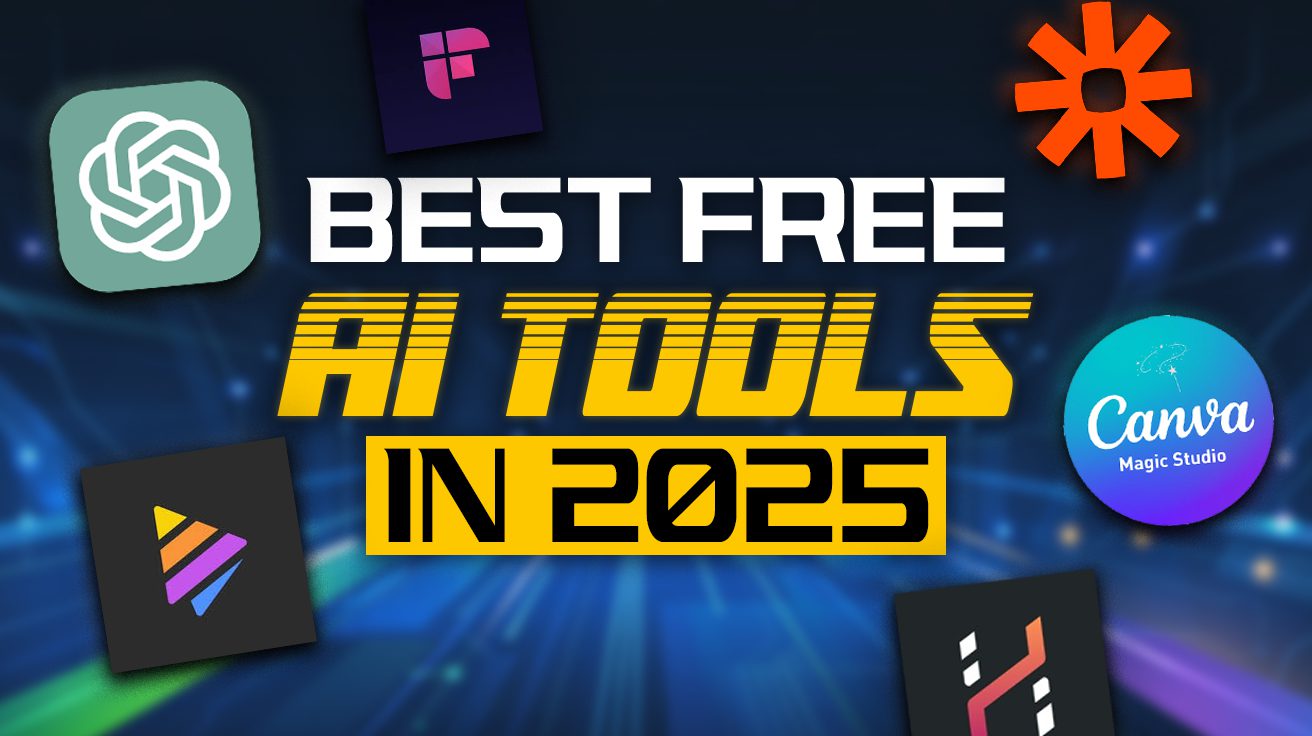Remember when AI tools were just fancy tech demos that promised the world but delivered digital paperweights? Those days are gone. The current wave of free AI tools works so well, it feels almost illegal. From turning messy thoughts into slick visuals to making sense of meeting chaos, these offerings deliver genuine utility without raiding your wallet. Think of them as having Tony Stark’s J.A.R.V.I.S. at your fingertips, except you don’t need a billion-dollar company to access them.
The tools on this list aren’t just free in the “we ‘ll-take-your-data-instead” sense. According to experts such as Synthesia, they offer substantial functionality before hitting any paywalls, with generous limits that actually let you accomplish real work. Each brings something unique to your digital toolkit, whether you’re writing content, designing visuals, or trying to make sense of information overload.
10. ChatGPT: The Conversational AI Leader

ChatGPT has become the household name in AI for good reason – it delivers capabilities that feel straight out of science fiction. This conversational powerhouse handles everything from crafting emails to debugging code with a level of competence that continuously impresses. The interface is clean, responses are quick, and the learning curve is virtually non-existent.
The free tier gives access to GPT-3.5, which remains remarkably capable despite newer models stealing headlines. Features like multi-modal support let you upload images for analysis or generate content based on visual input. For everyday use, ChatGPT functions similarly to having a brilliant AI assistant who never sleeps, never complains, and never asks for a raise, though it occasionally needs fact-checking when venturing beyond common knowledge.
9. Fireflies.ai: Your AI Meeting Assistant

Note-taking during meetings creates an impossible choice: document everything and miss the discussion, or stay engaged and forget critical details. Fireflies.ai eliminates this dilemma by automatically joining your scheduled calls, recording the conversation, and creating detailed transcripts complete with highlighted key points and action items.
The seamless calendar integration means you simply schedule as normal, and Fireflies handles the rest. After meetings, searchable transcripts let you find exactly what was said without scrubbing through recordings. Integration with tools like Slack and Notion keeps everything in your workflow. Fireflies.ai operates like having a dedicated assistant whose only job is ensuring no valuable information slips through the cracks – freeing you to focus on the conversation instead of frantically typing.
8. Canva Magic Studio: Design for Everyone

Professional-looking design once required expensive software and years of training. Canva Magic Studio demolishes these barriers with AI-powered tools that turn anyone into a capable designer. The platform’s intuitive interface masks powerful capabilities that generate custom graphics, animate static images, or transform rough ideas into polished visuals.
The free plan provides access to thousands of templates and core design features that cover most everyday needs. Canva functions similar to having a design department in your pocket – one that works at the speed of thought rather than through multiple revision cycles. For small businesses, content creators, or anyone needing visual content without the traditional design headaches, Canva Magic Studio delivers professional results without the professional price tag.
7. Hugging Face Spaces: AI Democratized

Imagine a world where cutting-edge AI applications weren’t locked behind corporate walls or complex setups. Hugging Face Spaces makes this a reality by providing a platform where anyone can host AI demos. This open-source playground demystifies machine learning, turning what was once the domain of specialists into accessible tools for the curious.
The community aspect truly sets Spaces apart. Browse thousands of applications built by others or create your own without drowning in technical complexities. The platform works like YouTube for AI – discover, use, and contribute to a growing ecosystem of practical applications. For those looking to understand what’s possible with current AI technology, Hugging Face Spaces provides both the showcase and building blocks, and it is also available as an AI app that can be used on both Android and iOS.
6. Fathom: Reclaim Your Meeting Time

Meetings eat time like Cookie Monster devours cookies – enthusiastically and with little regard for moderation. Fathom fights back by automatically recording, transcribing, and summarizing meetings across Zoom, Teams, and Google Meet. The magic happens after everyone says goodbye – detailed summaries appear in your inbox with key points highlighted and action items neatly extracted.
Translation into 28 languages makes Fathom particularly valuable for global teams. Share snippets with colleagues who missed the meeting or search through transcripts to find that brilliant idea someone mentioned three weeks ago. The free tier gives you enough capacity for regular use, while the interface makes finding important information feel like having a superpower. No more frantic scribbling while trying to participate meaningfully in discussions.
5. Napkin AI: Visualizing Ideas

Remember trying to explain a complex idea with stick figures on a napkin? Napkin AI is essentially that napkin after it got bitten by a radioactive designer. This tool transforms your text descriptions into professional-looking infographics and social media visuals in seconds flat. Just type what you want, tweak the colors to match your vibe, and download – no design degree required.
Currently free during beta, Napkin AI gives you full ownership of everything you create. It shines brightest when you need quick social media graphics or want to transform bullet points into something people will actually look at. The tool works similar to having a graphic designer on standby, except this one never gets tired of your midnight revision requests.
4. Zapier: Automate and Thrive

Digital tasks often feel like playing whack-a-mole – handle one, and three more pop up. Zapier tackles this problem by connecting over 6,000 apps through no-code workflows called “Zaps.” Set up a trigger and action sequence once, then watch as tasks that once required manual attention happen automatically in the background.
The magic lies in Zapier’s accessibility. Without writing code, you can create workflows that move information between apps like a silent digital assistant. The free plan supports single-step automations that still deliver significant time savings. Think of Zapier as the digital equivalent of teaching repetitive tasks to a highly competent intern – set it up correctly once, and suddenly hours return to your week without sacrificing results.
3. Gamma: Content Creation Evolved

PowerPoint presentations generally inspire the same excitement as watching paint dry. Gamma flips this equation by letting AI handle the boring parts of content creation. Upload text, files, or links, and watch as they transform into polished presentations, documents, or interactive websites that actually look good without hours of formatting torture.
The free plan’s 400 monthly credits provide enough runway for multiple projects. Gamma’s card-based system makes customization intuitive – drag, drop, and you’re done. The platform functions like having a professional designer and content strategist working behind the scenes while you focus on messaging. For anyone who’s ever spent hours adjusting text boxes or searching for decent stock photos, Gamma feels like being handed back lost hours of your life.
2. Harpa AI: The Ultimate Browser Companion

Browsers haven’t changed much in the past decade – they’re still basically windows to view content through. Harpa AI transforms this experience by adding a layer of intelligence directly into Chrome and other Chromium browsers. This extension is the Swiss Army knife of browsing, packing multiple AI models (ChatGPT, Gemini, and Claude) into a single, easily accessible tool.
The practical applications border on mind-reading. Scan lengthy articles for key points, track price drops on products you’re eyeing, or generate emails based on webpage content. Harpa even monitors websites for changes, eliminating the need to constantly refresh pages. Using separate extensions for each of these tasks would clutter your browser worse than tabs at the end of a research rabbit hole – Harpa neatly packages them into one streamlined solution.
1. Notebook LM: AI Research Assistant

Information overload feels like trying to drink from a fire hose while someone keeps turning up the pressure. Google’s Notebook LM tackles this digital deluge by acting as your personal research ally. Fed by Google’s Gemini 2.0 AI, this tool digests PDFs, audio, video, and websites, then serves up concise summaries you can actually use.
What sets Notebook LM apart is its academic integrity. Unlike other AI tools that treat citations as optional accessories, this one meticulously tracks where information came from. For students and researchers, this feature alone justifies adding it to your workflow. The tool handles the grunt work of organizing information, freeing your brain cells for actual analysis instead of copy-pasting between documents.




























